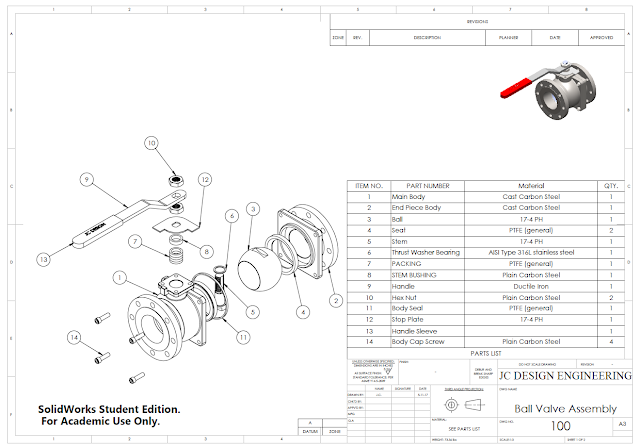Background:
For this project, I decided to learn the basics of the mechanical design that goes into making a ball valve. They are used extensively in many industrial applications such as clean water services and petrochemical services. Ball valves are a type of on-off valve, and they use a rotary quarter turn-type of operation that can be done either manually or by an actuator. Ball valves can come in many configurations, which allows them to be very versatile. The main type of differences in configuration occurs in: seat type, connection ends, bore(port) type, split body, ball design (e.g. floating vs trunnion), and materials.
Animation:
Everything was modeled by me from scratch in SolidWorks and I used valve handbooks, product catalogs from various valve companies, & ASME standards to help me choose the materials and dimensions for this project. I'm not an expert with ball valves so I may have more improvements to make. Feel free to comment down below with any constructive criticism.
Applicable Design Standards:
-Valve Design: ASME B16.34
-Flange Dimensions: ASME B16.5
-Face to Face Dimensions: ASME B16.10
 |
Cutaway Section of My Ball Valve Project |
My Design:
-Ball design: floating ball
-Size and pressure class: 4" valve using 150# pressure class
-Split body? yes, 2-piece cast body made of ASTM A216 WCB (low carbon steel), note: usually valves over 2" are cast
-Port type: Full port
-Entry: Side entry
-Seat type: Soft-seated
-End connection: Raised face flanged (see ASME B16.5)
-Application: Clean water service at low temps and non-corrosive
-Operation: Manually operated, no actuator
-Fireproof? no (not using anti-static stem design + graphite packing & body seal)
 |
Exploded View of Assembly |
Materials:
-Body: ASTM A216 WCB (low carbon steel)
-Trim: 17-4ph Stainless Steel (includes stem, ball, thrust bearing/washer, stem bushing/packing follower)
-Seats: PTFE (provides excellent bubble-tight sealing)
-Body Seal: PTFE
-Packing: PTFE (good for low temps and cheap)
-Handle/lever: Ductile iron
-Stop plate: 17-4ph Stainless Steel
 |
Drawing with Parts List |
 |
Dimensions from ASME Standards |
Design Considerations:
Soft seated vs. metal seated?
Use a soft seated design when you need better sealing, since soft seats provide better shut-off and bubble tight shut-off. Soft seats also require a lower torque due to having a low coefficient of friction. Use metal seats when you have a corrosive fluid since soft seats will wear quickly in these applications. For severe conditions such as high pressure, high erosion or abrasion, slurry and high temperature, it is preferred to use metal seats. Soft seats are generally made of a thermoplastic materials such as PTFE. Metal seats are usually made of 316 SS, and can even be hardened by coatings such as chromium carbide or tungsten carbide.
Anti-Static Stem Design for Fire Proofing:
If you are using a flammable fluid as the medium for your valve, you should design the stem with anti-static features in order to prevent the build-up of static electricity from the constant rubbing of the ball against the PTFE seats. A stem using an anti-static design, will use spring loaded stainless steel balls to provide electrical continuity. The balls will keep contact between the stem and ball slot and the stem and body, which will ensure that all metal valve parts are grounded.

This comment has been removed by a blog administrator.
ReplyDeleteThis comment has been removed by a blog administrator.
ReplyDeleteThis comment has been removed by the author.
ReplyDeleteThis comment has been removed by a blog administrator.
ReplyDeleteThis comment has been removed by a blog administrator.
ReplyDeleteThis comment has been removed by a blog administrator.
ReplyDelete